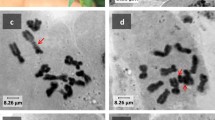Summary
A population of the grasshopper Calliptamus palaestinensis Bdhr. from near Jerusalem, Israel was analyzed cytologically. Twenty-two percent of the males had extra heterochromatic chromosome segments or supernumerary chromosomes. The extra segments were present in either a heterozygous or a homozygous condition and in frequencies similar to those expected according to the Hardy-Weinberg law.
The supernumeraries were heteropycnotic in the first meiotic division but paired and segregated regularly. In almost all the males with supernumeraries the number of supernumeraries varied between follicles in the testes but was constant within each follicle. Only 12.3% of the males had supernumeraries, but among those with supernumeraries the majority had means higher than 1.5. A calculation based on the frequency of the supernumeraries in the zygotes which are expected in the next generation indicated that of the 31 males with supernumeraries, probably not more than 3 males originated from zygotes with more than a single supernumerary. The variation in the number of supernumeraries and the high means probably resulted from preferential non-disjunction of the supernumeraries in the early mitoses prior to the differentiation of the follicles.
Mitotic non-disjunction of supernumeraries as the cause of intra-individual variation is considered. It is suggested that variation due to non-disjunction would be maintained only in association with accumulation mechanisms.
Similar content being viewed by others
References
Bosmark, N. O.: On accessory chromosomes in Festuca pratensis. II. Inheritance of the standard type of accessory chromosomes. Hereditas (Lund) 40, 425–437 (1954).
Carrol, M.: An extra dyad and an extra tetrad in the spermatogenesis of Camnula pellucida (Orthoptera): Numerical variation in the chromosome complex within the individual. J. Morph. 34, 375–455 (1920).
Evans, H. J.: Supernumerary chromosomes in wild populations of the snail Helix pomatia L. Heredity 15, 129–138 (1960).
Fröst, S.: A new mechanism for numerical increase of accessory chromosomes in Crepis pannonica. Hereditas (Lund) 46, 497–503 (1960).
Itoh, H.: Chromosomal variation in the spermatogenesis of a grasshopper, Locusta danica L. Jap. J. Genet. 10, 115–134 (1934).
Lewis, K. R., and B. John: Breakdown and restoration of chromosome stability following inbreeding in a locust. Chromosoma (Berl.) 10, 589–618 (1959).
Melander, Y.: Accessory chromosomes in animals, especially in Polycelis tenuis. Hereditas (Lund) 36, 19–38 (1950).
Müntzing, A.: A new category of chromosomes. Proc. X. Internat. Congr. genet. vol. 1, pp. 453–467 (1958).
Nur, U.: Meiotic behavior of an unequal bivalent in the grasshopper Calliptamus palaestinensis Bdhr. Chromosoma (Berl.) 12, 272–279 (1961); - A supernumerary chromosome with an accumulation mechanism in the lecanoid genetic system. Chromosoma (Berl.) 13, 249–271 (1962).
Östergren, G.: Heterochromatic B-chromosomes in Anthoxanthum. Hereditas (Lund) 33, 261–296 (1947).
Rothfels, K. H.: Chromosome complement, polyploidy and supernumeraries in Neopodismopsis abdominalis (Acrididae). J. Morph. 87, 287–316 (1950).
White, M. J. D.: Animal cytology and evolution, 2nd edit. Cambridge: Cambridge University Press 1954.
Author information
Authors and Affiliations
Additional information
Postdoctoral Trainee in Biology, U. S. Public Health Service, 1962–1963.
Rights and permissions
About this article
Cite this article
Nur, U. A mitotically unstable supernumerary chromosome with an accumulation mechanism in a grasshopper. Chromosoma 14, 407–422 (1963). https://doi.org/10.1007/BF00326786
Received:
Issue Date:
DOI: https://doi.org/10.1007/BF00326786



